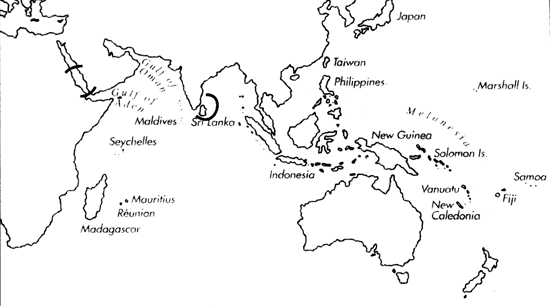
Skip Navigation Links
View access keys for this site.

Range: S. Red Sea and Sri Lanka.
Description: Moderately small to moderately large, moderately solid to solid. Last whorl conical to ventricosely conical; outline convex at adapical third, straight below; left side sigmoid. Shoulder angulate. Spire of low to moderate height, outline concave to straight. Larval shell of about 2 whorls, maximum diameter about 0.95 mm. About first 4 postnuclear whorls tuberculate. Teleoconch sutural ramps flat to slightly concave, with 1 increasing to 5-7 spiral grooves. Last whorl with single or paired granulose spiral ribs on basal half. Within adapical half, most ribs replaced by ribbons. In large specimens, sculpture obsolete adapically.
| Shell Morphometry | ||
|---|---|---|
| L | 31-58 mm | |
| RW | 0.11-0.37 g/mm | |
| RD | 0.56-0.68 | |
| PMD | 0.80-0.87 | |
| RSH | 0.12-0.23 | |
Ground colour white. Last whorl with yellow to brown axial flames and spirally aligned bars forming a variably distinct spiral band on each side of centre; an additional subshoulder band may be present. Larval whorl white. Postnuclear sutural ramps with radial streaks and blotches matching pattern of last whorl in colour. Aperture white.
Periostracum brownish grey, thin, smooth, translucent.
Habitat and Habits: In the Red Sea, on silt or sand in 210-800 m (Sturany, 1904).
Discussion: C. grangeri is most similar to C. rolani. The latter species is distinguished by its tuberculate postnuclear whorls, more larval whorls and strong sculpture on the last whorl, even in large specimens.

C. grangeri range map
This section contains verbatim reproductions of the accounts of 316 species of Conus from the Indo-Pacific region, from Manual of the Living Conidae, by Röckel, Korn and Kohn (1995). They are reproduced with the kind permission of the present publisher, Conchbooks.
All plates and figures referred to in the text are also in Röckel, Korn & Kohn, 1995. Manual of the Living Conidae Vol. 1: Indo-Pacific Region.
The range maps have been modified so that each species account has it own map, rather than one map that showed the ranges of several species in the original work. This was necessary because each species account is on a separate page on the website and not confined to the order of accounts in the book.
Return to framed version (returns to search page)